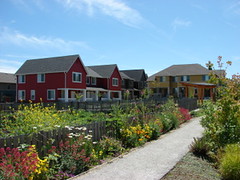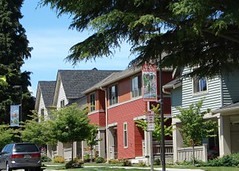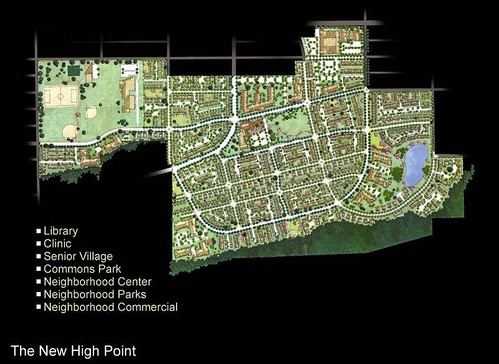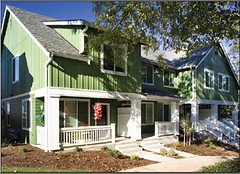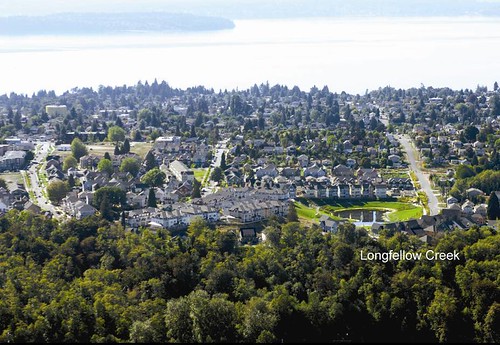Green, affordable, walkable, beautiful: Seattle's High Point neighborhood

Posted December 1, 2008 at 1:33PM
HOPE VI is by far my favorite government housing assistance program. Few in my world know how it got its name (Housing Opportunity for People Everywhere, Title VI - thanks, Payton), but we all know its mission of replacing stigmatized, outmoded public housing ghettoes with walkable, mixed-income neighborhoods, most of them based on the principles of new urbanism.
One of the best I've run across is Seattle's High Point, designed by Mithun Architects+Designers+Planners.
(Full disclosure: Mithun is headed by my friend and LEED-ND colleague Bert Gregory and employs my gifted AIA committee colleague Rachel Minnery. I decided to write about High Point, though, before I realized that Mithun was involved. High Point has also been assisted by Enterprise Community Partners, whose Green Communities program I have advised since its beginning.)
Here's a nice, succinct summary by the website housingpolicy.org:
"The High Point community in West Seattle is the city's largest housing site, and the first large-scale development in the country that features low-impact sustainable design in a dense urban setting. Replacing 716 units of distressed public housing, High Point includes a mix of income levels and housing types, all built to green standards. The pedestrian-friendly community offers substantial park space, and when fully completed will include a shopping center, senior village, and neighborhood center. A new medical/dental clinic and public library were also built in the neighborhood.
"High Point's design emphasizes environmental health and sustainability. The community includes a natural drainage system to manage storm water, improve water quality, and protect salmon habitat. Mature trees are being preserved and materials from the site's deconstructed homes are being reused. To protect air quality, 350,000 gallons of alternative bio ultra-low sulfur diesel fuel are being used for infrastructure construction. In addition, High Point includes 35 'Breathe-Easy' homes designed to reduce the risk of asthma in low-income children, and an environmental outreach program will help to improve resident health.
"High Point opened to residents in 2005 and is scheduled for completion by 2010."
The images in this post speak amply to the development's terrific design features, about as far from the image of "subsidized housing" as you can get. Yet its affordability characteristics are every bit as laudable: Of the development's 1600 rental and for-sale homes, half are sold or rented at below-market rates, exceeding the number in the old housing project that High Point replaces. In particular, 350 rental homes are priced to be affordable to households earning less than 30 percent of area median income (AMI); 116 are similarly priced but set aside for seniors; 250 rental homes are priced to be affordable to households earning less than 60 percent of AMI; and 80 for-sale homes are priced to be affordable to households earning less than 80 percent of AMI. 149 of the market-rate rentals are also reserved for seniors.
High Point can also boast a wonderful package of advanced green features, starting with its site, which recycles land from the deteriorating previous project, originally built in the 1940s as "temporary" wartime housing. The new community is compact and highly walkable, with a great street grid and lots of community gardens and parks on its 120-acre site. Its streets, unlike those of the old housing project, connect to nearby neighborhoods. (There is also access to two bus transit lines, though service is only provided on a half-hourly basis. Perhaps this will improve when the neighborhood is fully built.)
The advanced stormwater drainage system is designed to mimic nature and restore health to adjacent Longfellow Creek. One of the system's most important elements is 4 miles of swales, which replace conventional street curbs and gutters with vegetated drainage channels designed to collect, channel, and filter stormwater. Planted with grass, trees, and shrubs, the swales also offer additional neighborhood green space. Narrow street design further reduces the amount of pollutants, such as oil, that enter the system via runoff.
Other green features include high-efficiency and radiant heating; whole house fan and airtight drywall to reduce moisture; Energy Star appliances; Energy Star vinyl windows that reduce heat loss; and low-VOC flooring, cabinet construction and paint. Tom Phillips of the Seattle Housing Authority (SHA), whose excellent presentation I gleaned for this post, estimates that going green added about 3 percent to the neighborhood's overall cost. The results include lower utility costs for water and sewer  (down 5 percent per capita versus an otherwise comparable new development), electricity (down 21 percent), and natural gas (down 45 percent). In the Breathe-Easy homes, symptom-free days for residents with pulmonary problems have been significantly more frequent than in their previous homes, and urgent clinical care visits are significantly less frequent.
(down 5 percent per capita versus an otherwise comparable new development), electricity (down 21 percent), and natural gas (down 45 percent). In the Breathe-Easy homes, symptom-free days for residents with pulmonary problems have been significantly more frequent than in their previous homes, and urgent clinical care visits are significantly less frequent.
The SHA, High Point's developer, is an independent public corporation that functions as both a property manager and a nonprofit developer. High Point is being built with a sophisticated package of public and private investment, approximately a quarter of which is from federal HOPE VI funds. Stormwater control assistance and green incentives were provided by the city of Seattle. Enterprise provided equity derived from the federal Low Income Housing Tax Credit program.
From all indications, the new neighborhood is a living embodiment of its parent program's hopeful name.
Many thanks to Enterprise's Dana Bourland for providing me with great information about High Point.
